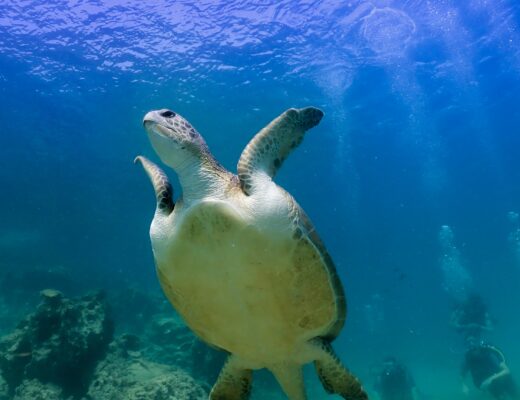Hier klicken für die deutsche Version
Leatherback, Green Turtle, Flatback, Hawksbill, Loggerhead, Olive ridley, and Kemp’s ridley, are the seven species of the sea turtles, how many of them have you heard about before?
In today’s post, I will share some facts about those majestic animals.
I would love to read what your most beautiful moment with an underwater animal (turtle) was, please feel free to share them in the comments.
In today’s post, I will talk about their diet and their enemies and predators and in next week’s post, I will go more into the human impact and how we can help protect this lovely species.
All Sea turtles belong to the Cheloniidae family, except for the Leatherback turtle, which is the only extant one that belongs to the Dermochelyidae family.
Their Diet
The most common diet in the world of sea turtles is omnivorous but it is the same as with us humans, not all sea turtles eat the same.
While the leatherback sea turtles (jellyfish) and the hawksbill sea turtles (sponge) prefer their main diet staying the same over their entire life, the green sea turtle is a bit more experimental and changes its diet as growing up. They start off being omnivorous but continue to be herbivores over their adulthood.
Not only the green sea turtle changes its diet, but also the loggerhead sea turtle, same as with the green sea turtle they start of being omnivorous but throughout their adulthood, they continue to be a carnivore.
The last three on our list just follow one diet, the olive ridley, and the flatback turtle are both considered omnivore, other than the kemp’s ridley which is considered to be a carnivore.
After I probably raised some confusion about what each diet is I will quickly explain that.
Omnivore: An omnivore is someone/something that eats everything in our case that fish, urchins, shrimp, algae, etc.
Carnivore: Carnivores are meat eaters, so their diet arises from fish, shrimp, crabs mollusks, or jellies.
Herbivore: The diet of a herbivore consists of algae, grasses, and seaweeds

Who are their enemies?
It’s not an uncommon thing, for sea turtles to reach mortality before reaching adulthood, most of the hatchlings won’t even make it. Their enemies are not only the ones in the water but also animals such as seabirds, foxes, and raccoons who may raid their nests or even eat the hatchlings within their first minutes on earth.
After reaching the water their predators change to large fish or seabirds, the predators won’t fade, when growing up they will still have enemies for example large carnivores like crocodiles or sharks.
Even when being an adult they are not safe from on-land predators like Jaguars. Which would scoop out the flesh of the sea turtle.
Sadly when I was in Costa Rica I made an encounter with a dead turtle that was scraped out entirely.
But sadly one part we can’t forget, is that also us humans harm these beautiful animals, like when they end up being a bycatch from imprecise fishing methods, or when they get caught up in long lines.
I hope you learned a bit 🙂
Since I think this topic is really important, I will write an extra blog post discussing this sensitive topic and talk about ways to help. If it’s already uploaded you can just click here.
Thank you for reading today’s post hope to see you in my next post 🙂
Deutsche Version
Lederschildkröte, Grüne Schildkröte, Wallriffschildkröte, echte Karettschildkröte, unechte Karettschildkröte, Pazifische Bastardschildkröte und Kemps Bastardschildkröte, dies sind die sieben Spezies der Meeresschildkröten, von vielen hast Du schon einmal gehört?
In dem heutigem Post und in dem der nächsten Woche werde ich mit Euch ein paar Fakten über die sieben Spezies der Meeresschildkröte teilen. Diese Woche ist das Thema Ernährung und Feinde. Im nächsten Post werde ich über den menschlichen Einfluss und wie wir die Schildkröten schützen können, schreiben.
Mich würde es sehr freuen, Eure schönsten Erfahrungen mit Meeresschildkröten interessieren, also schreibt sie sehr gerne in die Kommentare.
Alle Meeresschildkröten gehören zu der Familie der Cheloniidae, außer die Lederschildkröte, welche die einzige noch lebende Spezies der Dermochelyidae Familie ist.
Ernährung
Die gängigste Ernährungsweise in der Welt der Meeresschildkröten ist omnivor, aber genau so wie bei uns ernähren sich nicht alle Schildkröten gleich.
Während die Lederschildkröte (Quallen) und die echte Karettschildkröte (Schwämme) eine durchgehende Ernährungsweise führen, ist die Grüne Meeresschildkröte ein bisschen experimenteller, sie ändert ihre Ernährung wenn sie erwachsen wird, zu Beginn sind sie Allesfresser, werden dann aber zu Pflanzenfressern.
Nicht nur die Grüne Meeresschildkröte ändert ihre Ernährung, sondern auch die unechte Karettschildkröte, wechselt von einem Allesfresser zu einem Fleischfresser.
Die letzten drei Schildkröten auf unserer List folgen nur einer Ernährungsweise, die Pazifische Bastardschildkröte und die Wallriffschildkröte sind beide Allesfresser, anders als die Kemps Bastardschildkröte welche ein Fleischfresser ist.

Ihre Feinde
Es ist nicht ungewöhnlich für Schildkröten zu sterben bevor sie es überhaupt ins Wasser schaffen, das liegt vor allem daran das ihre Feinde nicht nur im Wasser sind sondern auch an Land, wie zum Beispiel Füchse, Seevögel oder Waschbären, welche Neste plündern und teilweise sogar die jungen Schildkröten essen.
Aber auch im Wasser sind sie nicht sicher, da wechseln die Feinde aber zu großen Fischen, Seevögeln und anderen großen Fleischfressern wie Krokodile oder Haie.
An Land gibt es nach wie vor Feinde wie zum Beispiel Jaguar, welche das Fleisch aus den Schildkröten auskratzen.
Leider bin ich einer solchen Schildkröte in einem der Nationalparks in Costa Rica begegnet, ich weiß jedoch nicht, ob der Übeltäter ein Jaguar war.
Wir dürfen aber nicht vergessen, dass auch ein großer Feind der Schildkröten die Menschen sind, denn oft landen die Schildkröten als Beifang in den Netzen der Fischer oder verheddern sich in den Fischerleinen.
Weil mir das Thema“menschlicher Einfluss“ und „das Beschützen der Schildkröten“ sehr wichtig ist, werde ich nächste Woche einen separaten Blog post dazu machen. Wenn er schon online ist, könnt ihr einfach hier klicken.
Vielen Dank fürs Lesen und bis zum nächsten Mal. 🙂

